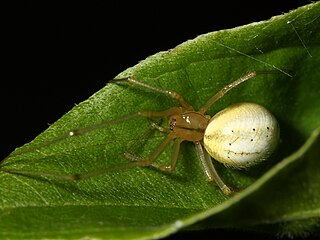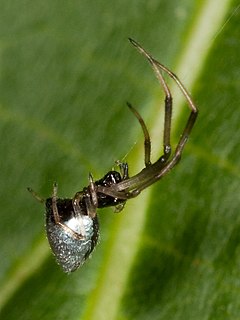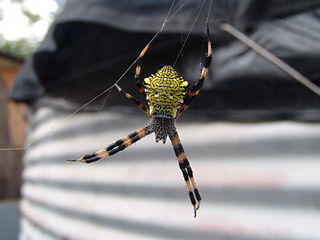
Theridiidae, also known as the tangle-web spiders, cobweb spiders and comb-footed spiders, is a large family of araneomorph spiders first described by Carl Jakob Sundevall in 1833. This diverse, globally distributed family includes over 3,000 species in 124 genera, and is the most common arthropod found in human dwellings throughout the world.

Argyrodes, also called dewdrop spiders, is a genus of comb-footed spiders that was first described by Eugène Louis Simon in 1864. They occur worldwide, and are best known for their kleptoparasitism. They can spin their own webs, but tend to invade and reside in their hosts' webs. This relationship can be commensal or even mutual if the dewdrop spider feeds on small trapped insects that are not eaten by the host. Some species can even prey upon the host.

Argiope appensa is an orb-weaving spider belonging to the family Araneidae.
Argyrodes argentatus is a kleptoparasitic spider.

Argyrodes flavescens, commonly called the red and silver dewdrop spider is a species of spider belonging to the family Theridiidae. It is widely distributed in Southeast Asia and is also found in Sri Lanka. Like other members of this genus, this species is a kleptoparasite, living on the web of a larger spider and feeding off its prey. A. flavescens most commonly inhabits the webs of araneids.

Cyrtophora exanthematica are tent spiders common in tropical Asia and Australia. They are commonly known as double-tailed tent spiders because of the pair of blunt projections at the end of their abdomens. They are harmless to humans.
Argyrodes rostratus is a species of tangle-web spider that is endemic to the Seychelles, and can be found on Mahé, Île Sèche, Cerf, Conception, Silhouette, Curieuse, Cousin, Aride, Praslin, La Digue, Grand Sœur, Felicite, Marianne, Denis islands and the Alphonse and St. François atolls. It is found in woodland, shrubby habitat and gardens, and is a kleptoparasite of red-legged golden orb-web spiders. It is threatened by habitat deterioration due to invasive plants, especially Cinnamomum verum.
Argyrodes fissifrons, the split-faced silver spider, is a species of spider of the genus Argyrodes. It is found in Sri Lanka to China and Australia.
Argyrodes nasutus, is a species of spider of the genus Argyrodes. It is endemic to Sri Lanka.
Argyrodes scintillulanus, is a species of spider of the genus Argyrodes. It is native to India and Sri Lanka.

Neospintharus is a genus of comb-footed spiders that was first described by H. Exline in 1950. It was synonymized with Argyrodes in 1962, but revalidated in 2004.
Argyrodes insectus is a species of spiders of the family Theridiidae that is endemic in Cape Verde. The species was first described by Günter E. W. Schmidt in 2005.
Argyrodes scapulatus is a species of spiders of the family Theridiidae that is endemic in Cape Verde. The species was named and first described in 1994.
Drassyllus lepidus is a spider in the family Gnaphosidae, in the infraorder Araneomorphae . The distribution range of Drassyllus lepidus includes the US and Mexico.

Argyrodes nephilae is a species of cobweb spider in the family Theridiidae. It is found in a range from the United States to Argentina and the Galapagos Islands.
Argyrodes pluto is a species of cobweb spider in the family Theridiidae. It is found in the United States, Mexico, and Jamaica.

Argyrodes elevatus, commonly referred to as dew-drop spider, is part of the family Theridiidae that consists of more than 3,000 species. These spiders are most commonly found in subtropical and tropical regions in South and Central America, as well as southern regions of the United States. One of the key distinguishing characteristics of A. elevatus is its kleptoparasitic behavior through which it primarily procures food for survival. Typically 1 or 2 A. elevatus spiders preside in outer areas of webs built by other species of spiders, although it is possible for up to 45 spiders. There are two main mechanisms by which A. elevatus raid the hub of the host’s web to steal insects preyed and wrapped by the host spider. A. elevatus follows an intricate course to the hub of the web to search for prey, using vibrational detection enhanced by laid out threads along the web to find and capture the insect. These spiders are highly efficient, with the theft lasting a maximum of 12 seconds and high success rates. This reliance on a host spider for food has led to adaptations in sleep schedules and alternate food sources to revolve around the host species activity. A. elevatus display a unique courtship routine in which male A. elevatus presents prey wrapped in silk as a nuptial gift to the female spider. The male spider approaches the female, carrying the nuptial gift on its chelicerae while communicating with a distinct courting vibration, followed by copulation. Approximately twenty-four hours after the A. elevatus courtship and copulation series of events, the female spider will lay one to two eggs on the outer regions of the host's web.

Argyrodes antipodianus, also known as the dew drop spider, is a species of kleptoparasitic spider from the cobweb spider family found in Australia, New Zealand and New Caledonia.








